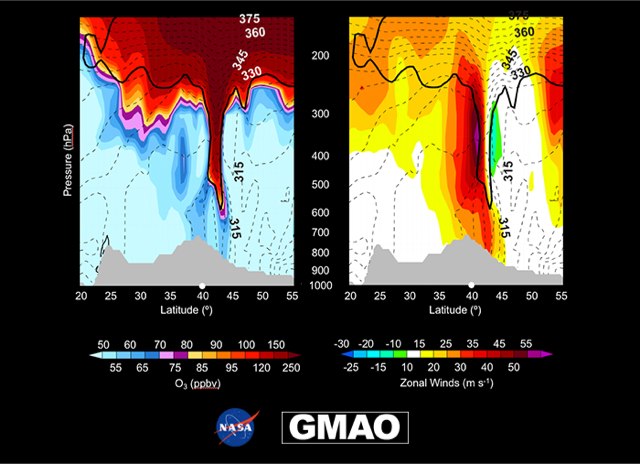Stratospheric Intrusion-Influenced Ozone Air Quality Exceedances Investigated in the NASA MERRA-2 Reanalysis
Stratospheric intrusions – the injection of stratospheric ozone-rich air into the troposphere – have been the interest of decades of research for their ability to increase surface level concentrations of ozone ( O3 ). While O3 in the stratosphere helps to protect life on earth from damaging solar radiation, O3 at the surface is an air pollutant regulated by the Environment Protection Agency (EPA). Until recently, model data misrepresented the fine-scale features of an intrusion which are best represented in horizontal resolutions of 50 km or smaller. NASA's MERRA-2 Reanalysis is an ideal candidate for the scientific studies of stratospheric intrusions since it is such a high-resolution global dataset and also assimilates both O3 and meteorological observations.
Stratospheric intrusions form as a result of the tropopause, the boundary between the stratosphere and troposphere (thick black line), being drawn down below the jet stream (strong upper-level winds, right panel). Tropopause folds are associated with:
- High O3 and high potential vorticity (PV)
- Low relative humidity (RH) and low carbon monoxide (CO)
Since assimilated satellite-retrievals of O3 are mainly stratospheric, MERRA-2 O3 captures stratospheric intrusions, however the O3 is biased elsewhere in the troposphere due to the simplified O3 chemistry in the model.
A stratospheric intrusion occurred over Colorado on 27 March 2012, leading to several hours with surface level O3 above the EPA's National Ambient Air Quality Standard (NAAQS) for the daily maximum 8 hour average O3. At the time of the highest reported O3 at Rocky Mountain National Park (40° N), the MERRA-2 tropopause and stratospheric O3 descend to about 600 hPa (left panel), being drawn down around a very strong jet at 350 hPa (right panel). The combination of both meteorological indicators and O3 in MERRA-2 makes this reanalysis dataset ideal for the identification of stratospheric intrusions.
Reference:
Knowland, K. E., Ott, L. E., Duncan, B. N., & Wargan, K. (2017). Stratospheric intrusion-influenced ozone air quality exceedances investigated in the NASA MERRA-2 reanalysis. Geophysical Research Letters, 44, 10,691–10,701. doi: 10.1002/2017GL074532


